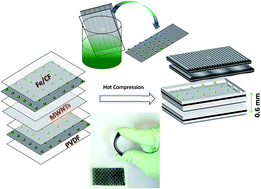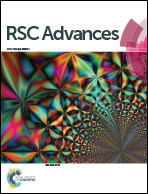Lightweight, flexible and ultra-thin sandwich architectures for screening electromagnetic radiation
Abstract
A lightweight and flexible multilayer structure consisting of poly(vinylidene fluoride) and iron particles deposited (electroless) on to a carbon nanofiber (CF) mat was successfully fabricated for electromagnetic interference shielding (EMI) application. The CF was pre-activated before depositing the iron particles by an electroless deposition technique. To enhance the shielding, a poly(vinylidene fluoride) PVDF composite containing multiwalled carbon nanotubes (MWNT) was sandwiched as an inner layer between two outer layers of iron particles deposited onto the CF mat (Fe@CF). The electroless deposition of iron particles onto the CF mat is reflected in a dramatically enhanced SE of ca. −54 dB (at 18 GHz) for an ultra-thin sheet of 0.6 mm as compared to the controlled sandwich structure (consisting of PVDF/CF) due to the presence of a conducting MWNT/PVDF film and magnetically active Fe@CF layer. This particular structure exhibits >95% absorption of the incoming EM radiation. Such a lightweight and flexible sandwich structure promises protection against EM microwave radiation.



 Please wait while we load your content...
Please wait while we load your content...